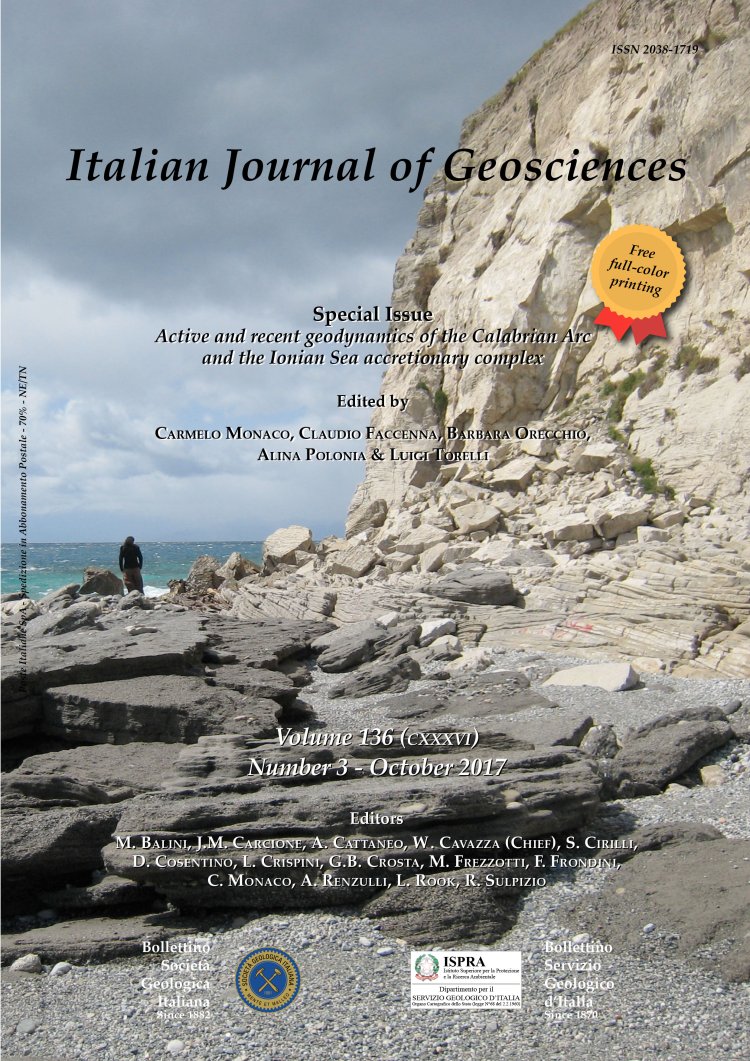
Present-day kinematics and deformation processes in the southern Tyrrhenian region: new insights on the northern Sicily extensional belt
Barbara Orecchio (1), Marco Aloisi (2), Flavio Cannavò (2), Mimmo Palano (2), Debora Presti (1), Fabio Pulvirenti (3), Cristina Totaro (1), Giusepp e Siligato (4) & Giancarlo Neri (1)
(1) Department of Mathematics, Computer Sciences, Physics and Earth Sciences, University of Messina, Italy.
(2) Istituto Nazionale di Geofisica e Vulcanologia, Osservatorio Etneo-Sezione di Catania, Catania, Italy.
(3) Shanghai Astronomical Observatory, Chinese Academy of Sciences, Shanghai, China.
(4) GNSS.it, Taormina, Italy.
Corresponding author e-mail: orecchio@unime.it. University of Messina - Viale F. Stagno d'Alcontres 31 - 98166 Messina - Phone 0039-090-6765102 - Fax 0039-090-392333.
Volume: 136 (2017) f.3
Pages: 418-433
Abstract
We performed a new analysis of updated and accurate sets of seismic and GNSS data relative to the southern Tyrrhenian region. Detailed velocity field and crustal strain distribution coming from integration of episodic and continuous measurements at more than 160 geodetic sites (spanning the 1994-2015 period) have been evaluated together with the spatial distribution of recent seismicity and an updated catalogue of waveform inversion fault-plane solutions relative to the period 1976-2014. In agreement with previous investigations, we have found that the kinematics of the study area is quite homogeneous except for the north-eastern corner of Sicily which moves almost coherently with southern Calabria in response to the SE-ward rollback of the Ionian slab. The rest of the study region shows a NNW-trending velocity field in agreement with the direction of the Nubia-Eurasia convergence and it is mainly interested by a major compressive domain. NNW-oriented compression is particularly highlighted by seismic data along the E-W trending seismic belt located in the southern Tyrrhenian Sea. In the framework of such compressive regime, the E-W trending extensional domain of northern Sicily is also clearly depicted both by seismic and geodetic data. The cause of this extensional domain framed inside a mainly compressive one represents an open question in the recent scientific debate. Comparisons between our results and literature information on regional geology and crustal structure led us to investigate whether the extension could occur as local response to the thrusting dynamics of the southern Tyrrhenian belt, favoured by the presence of pre-existing weakness zones. We then propose a first attempt to evaluate such a possible causal relationship by means of Finite Element Method (FEM) and Coulomb Stress Change (CSC) modelling. In particular, we adopted a FEM approach to investigate the deformation pattern produced by thrust faulting of southern Tyrrhenian belt, along a 2D profile crossing both the compressive belt and the extensional one in northern Sicily. We also estimated the CSC due to the thrust faulting on normal receiving faults fairly reproducing pre-existing structures of northern Sicily. Modelling results indicate that the thrust faulting activity along the Southern Tyrrhenian compressive margin could be effective in promoting extensional processes in northern Sicily. We have so shown that the local response to thrust faulting activity may concur, even in combination with other processes, to generate the crustal stretching of northern Sicily.
Keywords
Get Full Text Attached